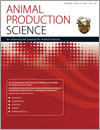
Animal Production Science
Volume 60 Number 10 2020
9th International Deer Biology Congress, Estes Park, Colorado, USA, 2018, and 4th International Symposium on Antler Science and Product Technology, Changchun City, Jilin Province, China, 2018
ANv60n10_FO9th International Deer Biology Congress and 4th International Symposium on Antler Science and Product Technology
AN18674Integrating fertility preservation and cryo-banking into the conservation of rare and endangered deer species
Preserving fertility and freezing reproductive samples from deer species are critical areas that still need to be thoroughly studied to ensure the conservation success of endangered populations in the wild and in captivity. Although fawns from rare deer species have been born from artificial insemination or embryo transfer, those techniques are not integrated into the management of populations. There is now an urgent need for improved strategies and more fertility preservation options.
AN19168Deer antlers: traditional Chinese medicine use and recent pharmaceuticals
Deer velvet antler is traditional Chinese medicine for treating yang-deficiency syndromes. However, VA still largely remains a traditional remedy with scant science. We are trying to develop some efficacious drugs and functional food based on the unique biological phenomena of VA, such as anti-inflammatory properties, healing without leaving scars, and calcification reversion, from researching antler biology. Successful translation of these unique phenomena to clinical use would greatly benefit human health.
AN19040Impacts of nutrition on reproduction in female red deer: phenotypic flexibility within a photoperiod-mediated seasonal cycle
Red deer (Cervus elaphus) exhibit annual seasonal cycles of reproduction largely mediated by genetically controlled responses to photoperiod. However, recent researches on farmed red deer in New Zealand have identified phenotypic variation in seasonal breeding under environmental control. These include impacts of female body condition during the mating and lactation periods on conception date, the influence of mid–late gestational feeding on gestation length and early life nutritional influences on body-mass set points for female entry into puberty. These non-genetic mechanisms may contribute to the species ability to naturalise to new environments that differ seasonally from ancestral environments.
AN19418Animal responses to environmental variation: physiological mechanisms in ecological models of performance in deer (Cervidae)
The performance of deer is moderated by innate predictive–adaptive mechanisms that govern the limits of responses to environmental variation. Interpreting functional responses in such terms enriches our appreciation of animal–environment interactions beyond that offered by the correlative structure of many ecological models.
AN18688The next frontier for recovering endangered huemul (Hippocamelus bisulcus): how to avoid recurrent misdiagnoses of health status and risks
The few opportunities to examine endangered huemul result in repeated misdiagnoses of the health status. Initial clinical and risk assessments were reinterpreted. Several cases of osteopathology were missed; reanalysis showed highly prevalent selenium deficiency; permits for capturing huemul and establishing breeding centres were denied repeatedly. Future evaluations should address osteopathology, risk assessments should be transparent and based on the assessments by multiple qualified professionals, so as to prevent unwarranted delays in conservation progress.
AN19377Acoustic parameters of courtship and human-directed friendly vocalisations in seven species of Neotropical deer in captivity
Old World male deer have been found to produce an enormous variety of loud, complex vocalisations during their reproductive period, with a great variety among species and subspecies. No recordings or analysis exist for Neotropical deer; here, courtship bleats were recorded from males of seven species and found to be quite similar. Differences between males of two of the species may serve to help females distinguish between their own and the other species.
Wildfire and prescribed burns are common across many mule deer habitats; yet, published literature is equivocal relative to how mule deer respond to burned habitats or treatments intended to improve them. On the Kaibab Plateau in northern Arizona, mule deer used winter-range areas where wildfires had reduced the overall plant height and where vegetation treatments intended to restore habitats were ≤6 years old. Wildfires may, thus, have positive effects on habitats for wildlife, provided that fire severity is not extreme, and particularly when efforts to recover native vegetation allow mule deer to move through successively productive areas.
AN19376High fibre selection by roe deer (Capreolus capreolus): evidence of ruminal microbiome adaption to seasonal and geographical differences in nutrient composition
 , Martina Hudler, Wilhelm Windisch, Carmen Bolduan, Daniel Brugger and Andreas König
, Martina Hudler, Wilhelm Windisch, Carmen Bolduan, Daniel Brugger and Andreas König 
European Roe deer are ruminants and are able to digest a variety of plant constituents, especially fibre. They owe their ability to do this to the microorganisms in their rumens, which make the nutrients in their food available to them. The composition of the microbiome changes continuously, depending on the given food and allows the animals to adapt very well to the changing food availability, conditioned by different seasons and habitats.
AN19375Response of roe deer (Capreolus capreolus) to seasonal and local changes in dietary energy content and quality
 , Martina Hudler, Sarah-Alica Dahl
, Martina Hudler, Sarah-Alica Dahl  , Carmen Bolduan, Daniel Brugger and Wilhelm Windisch
, Carmen Bolduan, Daniel Brugger and Wilhelm Windisch
Across large areas of Europe, the agricultural landscape is continually changing, and with it the vegetation in the countryside. Roe deer are the most common species of deer here. Roe deer are originally forest dwellers; it is fascinating to investigate how they adapt to these changes in the availability of forage, and whether supplementary feeding is necessary to maintain their numbers.
AN19375 Abstract | AN19375 Full Text | AN19375PDF (467 KB) Open Access Article
AN19553Effects of macrophage-conditioned medium on sika deer (Cervus nippon) antler stem cells
The immune system is closely related to regeneration. To explore the possible role of macrophages in antler regeneration, we treated pedicle periosteum cells (PPCs) with macrophage-conditioned medium (MCM). We found that MCM had a great influence on PPCs, and that macrophages might regulate antler regeneration through altering the microenvironment and gene-expression profiles of PPCs. We believe that the results would facilitate the discovery of the roles of immune system in antler regeneration and, thus, mammalian organ regeneration in general.
AN19682Effects of an antler velvet-based natural compound on osteoporosis in a rodent model
Velvet antlers are claimed to have the effects on osteoporosis in traditional Chinese medicine. A velvet antler-based compound was produced and administered to osteoporotic model rats. The results showed that the compound was effective in treating osteoporosis in model rats and even comparable to Western medicine on the basis of our selected parameters. We believe the compound has the potential to be developed as an effective traditional Chinese medicine for clinical use to treat osteoporosis.
It is important to establish a method to distinguish velvet antlers (VA) from other types of deer tissue. In the present study, fingerprints of VA, venison and deer bone were established using HPLC and analysed using chemometric methods. The HPLC fingerprints in combination with chemometric methods can be used to effectively distinguish the three deer tissue types, namely, VA, venison and deer bone, offering a much needed useful tool in the current Chinese velvet market.
AN19510Deer blood effectively improved clinical signs of anaemia in a rodent model
Scientifically designed studies with strict controls were conducted for the evaluation of therapeutic effects of deer blood on iron-deficiency anaemia. Three doses of deer blood (low, mid and high) were used to treat iron-deficiency anaemia model rats. Results showed that both deer blood-mid and deer blood-high groups had significantly increased iron concentrations in the liver, spleen and kidney of rats, compared with all other groups, including the positive-control group. We believe our study has opened a new avenue for the development of deer blood as a drug to treat iron-deficiency anaemia in clinics.
Deer velvet, which is derived from growing deer antlers, is a rarely used ingredient in traditional Chinese medicine, and it has multiple beneficial effects against skin diseases. In the present study, we determined whether bioactive substances derived from deer antlers possessed inhibitory effects against atopic dermatitis in a mouse model and explored the underlying mechanisms of action. The study strongly suggests that antler extract exhibits therapeutic effects against atopic dermatitis by regulating inflammatory response.
Velvet antlers are divided into four portions, namely, wax-like (WL), blood-colour (BC), honeycomb-like (HL) and bone (B) slices on the basis of traditional methods. However, there is no evidence at a molecular level of the accuracy of this classification. We took a transcriptional approach in the present study to assess the accuracy of the traditional classification. Results showed that these four portions were grouped into three clusters at a transcriptional level, using bioinformatics tools. We believe that this new classification can contribute to velvet antler industry through modern scientific standardisation of velvet antler portions.



